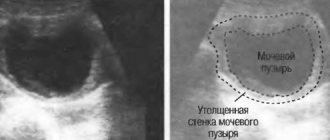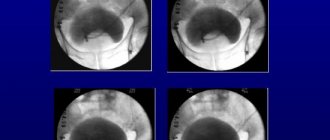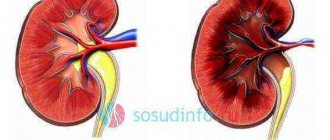Study of renal concentration function
| Home page / Urology / Study of renal concentration function |
| The concentration function of the kidneys refers to their ability to excrete urine with an osmotic pressure greater than that of blood plasma. The simplest way to study this function is to measure the relative density of urine. The relative density of urine depends on the concentration of substances dissolved in it, mainly urea. Normally, during the day, the relative density of urine varies widely - from 1.004 to 1.030 (usually from 1.012 to 1.020). If the relative density of urine in any of the portions taken during the day (with normal fluid intake) reaches 1.018-1.020, then this is considered a sign of the preservation of the concentration function of the kidneys. For a more detailed assessment of this function in clinical practice, the Zimnitsky test and the concentration test are most often used. The Zimnitsky test consists of collecting portions of urine every 3 hours during the day (eight portions in total) with determining the volume and relative density of urine in each portion. At the same time, the volume of fluid taken by the patient per day with drink and liquid food or during intravenous infusions is taken into account. Based on the test results, diuresis is determined daily, daytime (the amount of urine in the first four portions), nighttime (the amount of urine in the next four portions), the maximum and minimum relative density of urine, as well as the difference between them - the amplitude of fluctuations in the relative density of urine. Violation of the concentration function of the kidneys during the Zimnitsky test is expressed in a decrease in the minimum limit of the relative density of urine (hyposthenuria), as well as a decrease in the amplitude of fluctuations in the relative density of urine. In severe cases, isosthenuria is detected, in which fluctuations in the relative density of urine are observed in a narrow range - from 1.008 to 1.012. In addition, the Zimnitsky test allows you to objectively assess disorders of the water-excreting function of the kidneys: polyuria, oliguria and nocturia. The concentration test (with dry eating) is a functional load test and is carried out only after the Zimnitsky test, if the latter revealed isosthenuria or gave questionable results. During the concentration test, the patient does not drink for several hours and eats only foods with low water content (stale bread, fried meat, eggs, squeezed cottage cheese, etc.). Urine is collected at intervals of 2 or 3 hours (at night - one portion per 12 hours), determining the relative density of urine and the volume of each portion. As a rule, the duration of water deprivation in a test with dry eating is 24 hours (daily diuresis in this case usually decreases to 600-400 ml, and the volume of urine in two-hour portions - to 60-20 ml). The main indicator of the preservation of renal concentration function is the maximum relative density of urine achieved during the study. When the relative density of urine reaches 1.028-1.030 in any of its portions, the concentration function of the kidneys can be considered achieved and the test can be completed. The main diagnostic significance is a decrease in concentration function, which is often a sign of kidney damage of various etiologies, especially with predominant damage to the renal tubules. Thus, with the development of chronic renal failure, isosthenuria appears earlier than azotemia, and in some diseases (for example, chronic pyelonephritis) it can be detected earlier than a decrease in glomerular filtration. When assessing concentration tests, it should be taken into account that they can also be influenced by extrarenal factors. In particular, hyposthenuria can be observed with forced diuresis, a protein-free or salt-free diet, as well as during the period of resolution of edema. The most pronounced hyposthenuria is observed in diabetes insipidus, which is characterized by a decrease in the relative density of urine (up to 1.000-1.001, occasionally 1.004) with a small amplitude of fluctuations; in this case, even when conducting a concentration test, the relative density of urine does not exceed 1.007. The dry eating test is one of the main methods for the differential diagnosis of diabetes insipidus. |
medbaz.com
The need for kidney tests
Important. Pathologies of the excretory system are not uncommon, so kidney tests are prescribed quite often. They help to detect diseases in advance and identify their characteristics. Carried out in the following cases:
- If there are already pathologies of the kidneys or other organs: diabetes mellitus, high blood pressure, etc. Urinary disorders can act as complications.
- Constant use of medications, which can lead to disruption of the normal composition of the blood. If the indicators deviate, kidney disease is possible.
- During pregnancy, it is especially important to undergo such an examination. This will allow you to identify violations or a tendency to them in advance.
- To exclude the factor of heredity. In some cases, the predisposition is passed on to subsequent generations.
It is advisable to monitor your health, including on your own. The need for kidney tests arises when there are abnormalities in the functioning of the kidneys. They can be identified by the following signs:
- Swelling of the face;
- pulling pain in the lower back;
- frequent, prolonged headaches, high blood pressure;
- chills, increase, decrease in body temperature for unclear reasons;
- loss of strength, bad mood.
Having one or more of these symptoms does not necessarily mean you have kidney problems. You should not make a diagnosis and treat yourself. This is just a reason to get checked for disorders and take kidney tests.
Study of water excretion and concentration functions of the kidneys
The water-excreting function of the kidneys is judged by the amount of urine excreted, most often per day. Concentrating ability is determined by testing the specific gravity of urine. The specific gravity of urine is determined using a special device - a urometer (see). Already in itself, a sharp decrease in urine excretion by the kidneys, i.e., oliguria or anuria (see), as well as a significant increase in daily urine excretion, i.e., polyuria (see), indicate impaired renal function. A water test (dilution test), in which the patient is given 1.5 liters of water to drink on an empty stomach (according to Volhard), and then diuresis is measured every half hour for 4 hours, mainly depends on extrarenal factors, and therefore its importance in assessing renal function limited.
Of greater practical importance is the study of P.'s concentration ability, especially the test with dry eating. This test and its variants (Volhard's, Fishberg's, etc. tests) are based on the fact that for a certain time the patient receives only dry food containing large amounts of animal protein (in the form of cottage cheese, meat or eggs). In this case, separate portions of urine are collected (from 8 am to 8 pm or three morning hourly portions), in which the amount of urine excreted and its specific gravity are determined.
As a result of tests with dry eating in persons with normal renal concentration function, the amount of urine in individual portions drops sharply to 30-60 ml; 300-500 ml are released per day. At the same time, the specific gravity of urine increases and reaches 1.027-1.032 in individual portions.
If the concentration function of the kidneys is impaired, the amount of daily urine and the size of individual portions become significantly larger than normal. The specific gravity in any portion does not reach 1.025, and often does not exceed 1.016-1.018 (so-called hyposthenuria). With more pronounced disorders of the concentration function of the kidneys, dry eating may not have any effect on the nature of urination, and the specific gravity of urine may remain constantly low (within 1.008-1.014). A condition in which urine of a fixed low specific gravity is excreted is called isosthenuria. The specific gravity of urine is equal to the specific gravity of the protein-free plasma filtrate. Hypo- and especially isosthenuria are indicators of profound changes in the epithelium of the renal tubules and are found, as a rule, with wrinkled renal tubules.
However, a decrease in the concentrating ability of the kidneys may also depend on extrarenal influences (for example, with a decrease in the function of the pituitary gland in relation to the release of antidiuretic hormone). A test with dry eating should not be carried out if there is an indication of a violation of the nitrogen excretory function of the kidneys. An incorrect test result may occur if it is carried out in patients with edema, since dry eating contributes to the convergence of edema and the low specific gravity of urine in this case may not depend on renal failure, and from increased diuresis.
Due to its simplicity, the Zimnitsky test (1924) became widespread. This test is carried out without any stress, under normal living and nutritional conditions of the patient, and can be used in cases of impaired nitrogen excretory function of the kidneys. During the day, 8 portions of urine are collected (every 3 hours). In these portions, the quantity and specific gravity of urine are determined, and daytime and nighttime diuresis are calculated separately. Normally, there are significant fluctuations in both the quantity and specific gravity of urine in individual portions. In total, a healthy person excretes 75% of the liquid he drinks in the urine, most of it is excreted during the day, and less at night. With the Zimnitsky test, disturbances in the concentration function of the kidneys can be detected, but less reliably than with the test with dry eating, since the latter makes it possible to identify the maximum concentration ability of P. The specific gravity of urine with the Zimnitsky test in the range of 1.025-1.026 makes the subsequent test with dry eating unnecessary.
The study of the content of residual nitrogen and its fractions in the blood is one of the most important methods for studying kidney function. Residual nitrogen is the amount of nitrogen in the blood that is determined in it after the precipitation of proteins. Residual nitrogen (RN) is normally 20-40 mg% and consists of urea nitrogen (most, approximately 70%), creatinine nitrogen, creatine, uric acid, amino acids, ammonia, indican, etc. The amount of urea in blood plasma Normally equals 20-40 mg% (moreover, nitrogen makes up 50% of the urea molecule). The normal content of creatinine in the blood is 1-2 mg%, indican - from 0.02 to 0.2 mg%.
The data obtained from the study of residual nitrogen and its fractions in the blood cannot claim to identify early or subtle disorders of renal function, but are of significant importance for the clinic when judging the severity, i.e., the degree of renal failure. Even a slight increase in residual nitrogen in the blood (up to 50 mg%) may indicate a violation of the nitrogen excretory function of the kidneys. With a sharp impairment of kidney function and the development of azotemic uremia, the content of residual nitrogen and urea in the blood can reach 500-1000 mg%, creatinine 35 mg%. Azotemia in chronic diseases of the kidney develops relatively slowly, but in acute oligoanuric kidney damage, the increase in azotemia can be extremely rapid and reach the maximum values known in pathology. Azotemia of the same degree has unequal prognostic significance in acute and chronic uremia. The prognosis for chronic uremia is much worse.
An increase in residual nitrogen in the blood may also depend on extrarenal factors, i.e. azotemia can be extrarenal in individuals with healthy kidneys (with increased breakdown of proteins, during fasting, in febrile and cancer patients, with leukemia, with chloropenia developing with persistent vomiting or diarrhea). An increase in residual blood nitrogen can also occur during treatment with corticosteroids and is the result of their increasing effect on the catabolic phase of metabolism.
www.medical-enc.ru
What does a kidney test show?
As a result of the analysis, the level of certain substances in the body is revealed, after which the specialist examines the patient’s indicators, and then a profile is created for him. It clearly describes the presence and quantity of the following substances:
- Urea. It is the final product of digestion, and, therefore, determines the functional abilities of the kidneys. If they are not in order, then further diagnosis is carried out for the presence of diseases associated with the urinary system.
- Uric acid . It is excreted in the urine due to the breakdown of proteins and complex nucleotides. Its concentration in the blood should not exceed the optimal value. Otherwise, this may mean the manifestation of kidney stones and kidney failure.
- Creatinine. The substance whose indication has the most significant role in the well-being of the kidneys. With normal metabolism, it is completely excreted in the urine, so it should not accumulate and concentrate in large quantities in the blood. This leads to pathology.
- Electrolytes. These are some of the chemical elements found inside and outside the cellular environment. They are also important indicators of the functioning of the excretory system.
Important! Deviation from the norm is a prerequisite for the presence of serious diseases. It is necessary to identify and prevent them in the early stages, so consult a doctor promptly!
These substances provide a clear picture of the functioning of the urinary organs. It may not be very good due to excessive use of medications or the presence of chronic diseases. All this needs to be monitored and must be observed in moderation.
Kidney failure
The development of renal failure and the nature of renal dysfunction in chronic pyelonephritis have a number of features characteristic of this disease.
Since the inflammatory process is concentrated primarily in the intertubular tissue and affects the vessels supplying the renal tubules, very early (much earlier than in other forms of kidney disease) a disorder of the function of the tubules is observed, primarily in their distal part, and only later the function of the glomeruli is damaged .
In the cells of the proximal tubule, which are extremely complex in structure and function, rich in various enzymes, glucose, amino acids, and phosphates are absorbed. At the same time, reabsorption (reabsorption) of almost the entire amount of filtered sodium and reabsorption of water in the amount of about 80% of the volume of the glomerular filtrate occurs.
In the distal tubules, urine acquires its final concentration primarily due to the reabsorption of water in an amount of approximately 20% of the volume of the glomerular filtrate. Tubular reabsorption generally accounts for 98-99% of the total amount of filtered urine. The absorption of water in the distal tubules is regulated by the antidiuretic hormone of the pituitary gland.
In the cells of the distal tubules, the remaining amounts of filtered sodium along with chlorine are reabsorbed. Normally, about 1% of sodium filtered in the glomeruli is excreted in the urine (in the form of table salt). The absorption of sodium (which, as indicated, mainly occurs in the proximal tubule) in the distal region is accompanied by changes in urine reaction and pH equal to 4.5, which is due to the conversion of dimetal phosphorus of the glomerular filtrate into acidic dimetal salts. In the distal tubules, ammonia is also formed, believed to be from glutamic acid, and hippuric acid is synthesized.
The secretory function of the tubules in relation to some substances, for example iodine compounds, colloidal dyes, has been proven. The release of these substances occurs in the proximal tubules.
Deterioration of tubular function in chronic pyelonephritis primarily leads to impaired water reabsorption, which can be detected clinically by hyposthenuria and polyuria. Polyuria during the period of renal failure in chronic pyelonephritis can be very significant, sometimes even renal insipidal syndrome develops.
Insipidal syndrome in such cases is not a consequence of insufficiency of the pituitary gland in relation to the production of antidiuretic hormone, but is the result of selective insufficiency of the distal renal tubules, dysfunction of which is especially characteristic of renal failure in chronic pyelonephritis.
A decrease in the concentrating ability of the kidneys can be observed already in relatively early periods of development of chronic pyelonephritis and even in acute pyelonephritis. For advanced cases and pyelonephritic shriveled kidneys, hyposthenuria is characteristic with lower maximum figures for the specific gravity of urine (within 1006-1008) than in other renal diseases.
However, a decrease in the concentration function of the kidneys is not detected in all cases of chronic pyelonephritis, especially with a routine (total) study of the urine of both kidneys.
It is better identified with a comprehensive study of partial renal functions, as well as with the help of a separate study of the functions of the right and left kidneys.
Compared with glomerulonephritis and renal arteriolosclerosis, with the development of chronic pyelonephritis, an earlier disorder of the function of the peripheral parts of the tubule is observed, manifested by an earlier decrease in concentration ability, and later damage to the glomerular filtration.
In Fig. 1 presents data on the filtration and maximum concentration capacity of the kidneys in chronic pyelonephritis in comparison with chronic glomerulonephritis.
| Rice. 1. The relationship between the filtration and concentration abilities of the kidneys in chronic pyelonephritis and chronic glomerulonephritis. |
From them it is clear that with the same filtration rates, lower (on average) figures for the maximum specific gravity of urine are observed in chronic pyelonephritis compared to chronic glomerulonephritis. This shows that in chronic pyelonephritis, the concentrating ability of the kidneys, i.e., the function of water reabsorption in the tubules, is impaired earlier and suffers more than the filtration function of the glomeruli, compared with chronic glomerulonephritis, which is characterized by a significant and earlier impairment of the filtration function of the glomeruli.
Rice. 2 demonstrates earlier and more pronounced declines in renal concentrating function in chronic pyelonephritis compared with impairment of effective renal blood flow.
| Rice. 2. The relationship between renal blood flow and the concentration function of the kidneys in chronic pyelonephritis and hypertension. |
This figure compares data on renal blood flow according to the diodrast purification coefficient and the maximum specific gravity of urine in chronic pyelonephritis and hypertension. It is clear that in chronic pyelonephritis, the maximum concentrating ability of the kidneys is, on average, somewhat reduced even with normal indicators of effective renal blood flow and is significantly impaired when the renal blood flow remains moderately reduced. At the same time, in hypertension, a decrease in the concentrating ability of the kidneys is observed only with a pronounced and significant decrease in effective renal blood flow. Thus, in Fig. Figure 2 shows the secondary nature of the violation of the concentrating ability of the kidneys in relation to their circulatory disorders in hypertension and the primary, regardless of the state of effective renal blood flow, violation of the concentrating ability of the renal tubules in chronic pyelonephritis.
In chronic pyelonephritis, an earlier and more pronounced disturbance of the secretory function of the tubules is also detected in comparison with the effective renal blood flow.
Thus, when studying the maximum tubular secretion of Diodrast in patients with chronic pyelonephritis, we obtained data indicating a decrease in the maximum tubular secretion of Diodrast already in the early periods of the disease, even with normal renal blood flow. In contrast, in hypertension, a decrease in maximum tubular secretion of diodrast is observed later as a secondary phenomenon associated with a decrease in renal blood flow (see Fig. 3).
| Rice. 3. Comparative studies of renal blood flow and maximum tubular secretion in chronic pyelonephritis and hypertension. |
Predominant and earlier damage to the function of the distal tubules in chronic pyelonephritis is revealed when studying the concentrating ability of the kidneys in response to the administration of pituitary antidiuretic hormone. Normally, in response to the administration of antidiuretic hormone of the pituitary gland, there is a significant decrease in diuresis with an increase in the specific gravity of urine due to increased reabsorption of water in the distal tubules without a simultaneous increase in sodium reabsorption. In chronic pyelonephritis, already in relatively early periods of the disease, while maintaining the ability to concentrate urine in response to dry eating, after the administration of pituitrin, the specific gravity of urine does not increase, which indicates a predominant and early dysfunction of the distal tubules.
Damage to the function of the distal tubules, in addition to impaired concentration ability, is also manifested by a decreased ability to equalize osmotic balance, apparently due to impaired ammonia synthesis.
Later, when the proximal tubules are damaged, the ability to reabsorb sodium is impaired, which leads to increased excretion and contributes to dehydration and the development of chloropenic acidosis.
The decrease in alkaline reserve, observed early in chronic pyelonephritis, depends on a decrease in the concentrating ability of the kidney. In the most severe patients, increased potassium excretion is often observed, leading to hypokalemia.
Chronic pyelonephritis is characterized by uneven involvement of two kidneys in the pathological process, and often even damage to one kidney, which is manifested by asymmetry in the dysfunction of the right and left kidney.
Renal dysfunction observed in unilateral chronic pyelonephritis is of a peculiar nature. In cases of unilateral damage, a vicarious enlargement of the second kidney may be observed, which may be manifested by an increase in its function in the form of an increase in renal blood flow, an increase in maximum tubular secretion and filtration, etc. Therefore, with unilateral pyelonephritis at earlier stages of development without persistent and prolonged hypertension, which can lead to secondary dysfunction of a healthy kidney; during a summary study, not only not reduced, but normal and even increased indicators of kidney function can be observed.
Not only with unilateral, but also with bilateral pyelonephritis, due to frequent uneven lesions of the two kidneys, various dysfunctions of their functions can be observed. Predominant or exclusive dysfunction of one kidney can be easily identified clinically by studying the secretion of various substances by the kidneys when collecting urine separately from the two ureters. A significant difference was found in chronic pyelonephritis between the concentration indices of endogenous creatinine in the right and left kidneys, while normally in glomerulonephritis and arteriolosclerosis of the kidneys this difference is small.
It is also worth pointing out some features of the clinical course of renal failure in chronic pyelonephritis.
Renal failure in chronic pyelonephritis is characterized by slow, gradual progression. Initially, it manifests itself only as a decrease in concentration ability and polyuria, later - a decrease in the filtration function of the glomeruli, retention of nitrogenous wastes and the development of uremia.
However, it is characteristic that with an exacerbation of the inflammatory process in the kidneys, renal failure can rapidly progress until the development of a pronounced picture of azotemic uremia with the appearance of uremic pericarditis. But even at this stage, when the main inflammatory process in the kidneys subsides, an improvement in kidney function and the disappearance of symptoms of uremia may occur. In the future, kidney function may be satisfactory for a long time.
vip-doctors.ru
To whom and when are kidney tests prescribed?
Anyone can be referred for this examination, since kidney diseases are quite common. And the main task of the doctor and the patient is to identify the disease in order to get rid of it in a timely manner. However, it is worth considering when and under what circumstances tests are recommended and prescribed:
- The patient is taking medications that contribute to kidney damage and have a detrimental effect on the substances they contain. Because of this, the levels of creatinine, urea and uric acid may deviate from the norm.
- Risk of exposure to hereditary factors. This suggests that the diseases of your relatives could be directly or indirectly inherited by you. This problem cannot be ignored, because the next generation is also at risk if the pathology is not detected and eradicated.
- The presence of such diseases as: diabetes mellitus, a complication of which is renal failure; persistently high blood pressure; chronic pyelonephritis and others.
- Pregnancy. Oddly enough, it is especially important for expectant mothers to undergo such an examination in order to prevent all sorts of tendencies to problems with the body’s excretory system.
Remember: even without the intervention of your doctor, you must independently monitor the normal functioning of your organs. If you notice any abnormalities, go to the hospital immediately.
Symptoms of abnormalities in the functioning of the kidneys To be able to independently determine the onset of a particular disease, you should know the basic prerequisites for it. If there is a deviation from the norm, a person may experience the following symptoms:
- frequent and prolonged headaches;
- manifested swelling of the face;
- chills or fever;
- nagging pain in the lower back;
- unreasonable increase and decrease in temperature;
- high blood pressure.
The entire state of a person as a whole declines, which causes a decrease in efficiency and loss of vital energy. Physical and mental exhaustion occurs.
With kidney stones, nagging pain in the lumbar area is often observed
However, even if all the symptoms are present at the same time, you cannot make a diagnosis on your own and self-medicate - you need to consult a doctor. After the decoding of the renal profile is ready, you can take actions corresponding to the results.
When are sample collections scheduled?
Kidney tests are a complex of taking blood samples for analysis that evaluates the functionality of the kidneys.
Tests are indicated when suspicions arise or the diagnosis or course of the disease is clarified in the following cases:
- For existing kidney diseases to monitor performance, especially if the patient has high blood pressure, diabetes mellitus, chronic pyelonephritis, glomerulonephritis.
- If there are genetic kidney diseases in the family, for the earliest possible detection and diagnosis. This is especially important for congenital ailments or the identification of hereditary formations of any nature.
- When signs appear: headache, pressure surges, swelling, loss of appetite, pain in the lumbar region, fever - all those that signal a possible kidney infection.
- If the patient is taking nephrotoxic drugs.
- During pregnancy, even if the previous renal sampling is normal.
The renal complex includes only three research analyses:
- creatinine;
- urea;
- uric acid.
Being products of metabolism, these elements must be completely eliminated from the body. Therefore, abnormal concentrations of substances indicate dysfunction of organs and can be a harbinger of renal failure.
Important! According to international standards, kidney failure is determined by one of the tests - creatinine.
The difference between conventional renal tests and functional tests is significant. The first indicate the standards on the basis of which the specialist draws conclusions, the second are calculated according to given formulas based on the analyzes taken. It is believed that kidney function tests are more accurate and can more accurately assess the ability of an organ to concentrate and excrete fluids. Despite the complexity, tests are used quite often, especially in cases where the overall clinical picture is unclear.
Functional tests include indicators of glomerular filtration rate, creatinine clearance, and insulin clearance. Calculations are carried out taking into account the factors of the patient’s age, gender, diet and lifestyle. The samples should also be examined in detail.
Creatinine
It is believed that its value is relatively stable and if the patient is normally healthy, tests will show the volume and activity of total muscle mass. An increase means that:
- there is chronic renal failure against the background of chronic pyelonephritis, glomerulonephritis, polycystic kidney disease, urolithiasis, arterial hypertension and taking nephrotoxic drugs;
- the patient develops acute renal failure, provoked by the shock of large blood loss, severe dehydration or eclampsia;
- there are suspicions of acromegaly, gigantism, muscle injuries (in accidents);
- the patient has overexerted himself with heavy physical work or consumes a lot of meat dishes.
A decrease in creatine may indicate:
- presence of chronic renal failure;
- the patient's recumbent lifestyle with a decrease in overall muscle mass;
- taking glucocorticoids that increase blood flow;
- preeclampsia during pregnancy, when the kidneys no longer perform any filtration work and everything is excreted.
Standard values for creatinine:
- infants up to 28 days 12-48;
- children under 12 months 21-55;
- children 1-15 years old 27-88;
- women 44-104;
- men 44-110.
Urea
It can be increased due to adherence to a meat diet or during fasting, the presence of chronic renal failure, as well as in those conditions that are characteristic of an increase in creatinine. However, unlike the latter, urea shows long-term pathological processes without explaining acute ones.
Standard indicators of urea:
- infants up to 28 days 1.7-5.0;
- children under 12 months 1.4-5.4;
- children 1-15 years old 1.8-6.7;
- women 2.0-6.7;
- men 2.8-8.0.








